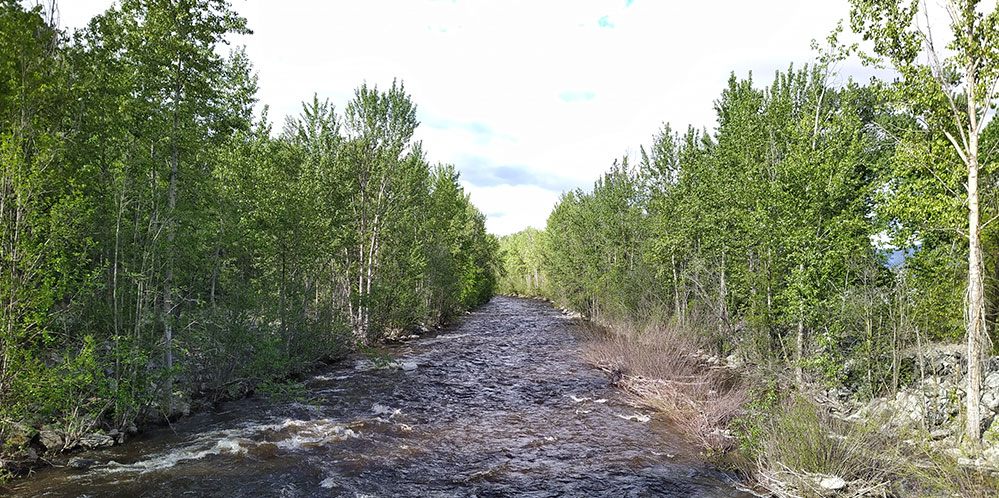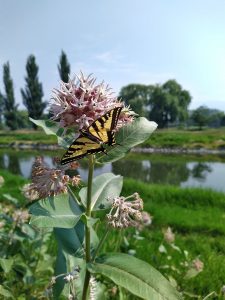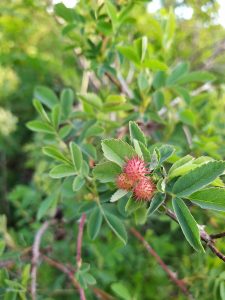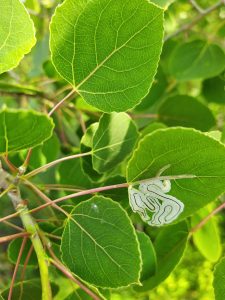
Mission Creek in spring freshet.
Madeline Donald, a PhD student in the Faculty of Creative and Critical Studies, received funding from the Public Humanities Hub Impact Awards in 2021. These awards are given with the objective of stimulating humanities research that engages the public.
The application read: “[P]articipatory puppetry is one way of bringing ecological processes of vegetal agency into a space imbued with human language (Jacobs, 2019). We will co-create a production with, about, and for, the community of riparian constituents in the Okanagan and Similkameen valleys.” This currently immaterial puppet show is called (for the time being) “Riparian Re-Animation.”
With this funding, Donald will create a community-based puppet theatre project intended to animate the interconnectedness of riparian habitats Okanagan and Similkameen valleys.
Madeline Donald introduces the project in this blog post.
The idea for this puppetry performance is rooted in two larger, ongoing research projects already underway at UBC Okanagan: WaterWays (p.i., Aleksandra Dulic) and the Enhancing Ecosystem Sustainability (EES) group (co-p.i.’s, Jeannette Armstrong & Lael Parrott). Both WaterWays and the EES group are working in conjunction with the Okanagan Nation Alliance and have identified riparian habitats as a key area for further research in Syilx territory. As a method of orienting myself to this work, I began a riparian photojournal in November, 2020. The photos you see here are have been selected from the resulting photojournal, the entirety of which can be seen on Instagram (@alsdeeend) or on the Open Science Framework.
Let us look to some ecological context. Riparian habitats form in the littoral zone, between running rivers and the grasslands of the Okanagan and Similkameen watersheds, two prominent watersheds in Syilx territory. These riparian zones are regularly dominated, in height and structure, and often defined by the presence and functions of cottonwood trees. Cottonwood riparian assemblages are ecologically diverse, interconnected entities (Decamps, 2001). Black and narrowleaf cottonwoods (Populus trichocarpa and Populus angustifolia) are keystone riparian species of ecological and biocultural importance who create moist skeletal infrastructures unparalleled in the semi-arid sagebrush ecosystems and grasslands of the valley bottoms. By growing tall and quickly, and falling long and often, cottonwoods bring water from rivers and creeks upwards into the air and nutrients downwards into the water. These dynamics of regeneration create a moist microclimate and dimensions of structure for floral and faunal members of the riparian communities. As ecosystem engineers, cottonwoods make and hold possibility for riparian biodiversity to thrive.
This community-based puppet theatre project is intended to animate the interconnectedness of these riparian habitats as a way of inviting people who call the Okanagan and Similkameen valleys home in to explore their relationships with(in) these cottonwood riparian forests. It’s hard to remember when this idea began to materialize. Possibly before, possibly after COVID-19 began to effect social interaction in British Columbia. 2020 was a year of temporal tumult. As I’m writing this I remind myself that it was not clear in early 2020 what the extent and duration of COVID’s impact on lives, livelihoods, and (p)research practice might be.
Riparian Re-Animation was initially conceptualized as a pre-research, or “presearch” project. For various reasons, its actualization has been delayed. Delay, in this case, has lead to accretion. Sometimes when I carry an idea in my carrier bag (Le Guin, 1988), bringing it out to weave in and through conversations, it grows and shrinks, ebbs and flows. Often I don’t even notice this happening; I’ll take the idea out for a spin and it’ll be a different shape, colour, weight, and texture than I remember it being. Much like the Hero in Le Guin’s explanation of her carrier bag theory of fiction, who when put in a bag “looks like a rabbit, like a potato” (10).
“We approach the script and puppet creation and performance process as one of slow, community-based creative ecological activism,” I wrote in the application, referring to myself and a cast of interested potential and potentially interested collaborators. “It is an intentional process of relationship forming between people and riparian environments and with the relationship that are highlighted in the performance. We are accountable to our relationships to these ideas and how those relationships move and change throughout the duration of this project.” Being accountable to these relationships has become more textured over time and through delay, that is an important part of the accretion process, and it means we need more time to do this puppet show well. Please stay tuned.
Works cited
Décamps, H. (2001). How a riparian landscape finds form and comes alive. Landscape and Urban Planning, 57(3–4), 169–175.
Jacobs, J. (2019). Phytopoetics. Catalyst: Feminism, Theory, Technoscience, 5(2).
Le Guin, U. K. (1988). The Carrier Bag Theory of Fiction. In D. Dupont (Ed.), Women of Vision: Essays by Women Writing Science Fiction (pp. 1–12). St. Martins Press.

A swallowtail butterfly feeds on showy milkweed at the tail end of their flowering season, Okanagan river.

Prickly rose growth, Okanagan river.

Trembling aspen leaves, illuminated by the sun and dined upon by a leaf miner, Okanagan river.